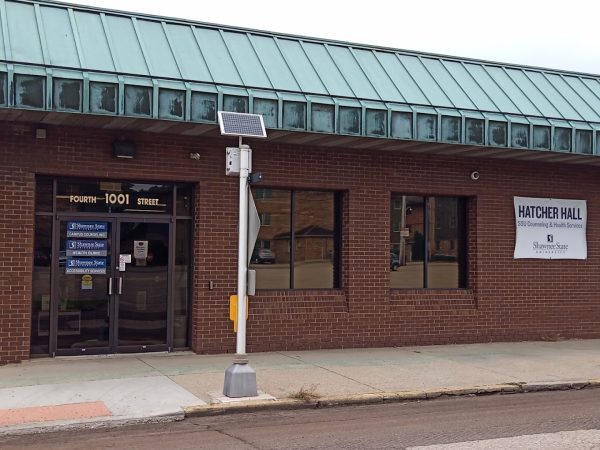How to Prepare for Winter Storms
And How to Properly Prepare and Handle Them
February 24, 2021
Over the last couple of weeks, there have been several winter storms hitting Ohio. While those storms seem to be over, for now, winter isn’t quite over yet and there is always the chance of another one happening. Winter storms can cause many things, roads being closed, power failures, or loss of communication services. So what should one do to prepare for a winter storm?
The Centers for Disease Control and Prevention, or CDC, has made a guide for what to do when preparing for a winter storm. It’s best that the building has things like insulated waterlines, a functioning smoke detector, and a carbon monoxide detector if your house or residence has a traditional heating system. It’s also best if the residence has a multipurpose, dry-chemical fire extinguisher near places where it would be needed. If you live on campus, then it’s likely that building preparations were already made to your housing, but it never hurts to check. If you do check and find something wrong or that the residence needs something, try sending a maintenance request form on the SSU website.
You should pay close attention to any weather forecasts, if the forecast says that a big winter storm is coming, it’s best to check if you have any disaster emergency kits. The American Red Cross suggests stocking at least three days worth of non-perishable foods and water. About one gallon of water per person per day. The kit should also include flashlights, a weather radio, extra batteries for the first two, a first aid kit and health supplies, a toolbox, hygiene products such as hand sanitizer, emergency contact information for family members as well as local resources, warm cloths and heat sources, or items that can melt ice such as rock salt or even kitty litter. The Red Cross suggests when preparing your home for a storm: “consider buying emergency heating equipment, such as a wood- or coal-burning stove or an electric or kerosene heater. – Stoves must be properly vented and in good working order. Dispose of ashes safely. Keep a supply of wood or coal on hand. – Electric space heaters, either portable or fixed, must be certified by an independent testing laboratory. Plug a heater directly into the wall socket rather than using an extension cord and unplug it when it is not in use. – Use a kerosene heater only if permitted by law in your area; check with your local fire department. Use only the correct fuel for your unit. Properly ventilate the area. Refuel the unit outdoors only, and only when the unit is cool. Follow all of the manufacturer’s instructions.”
If you see a warning ahead of time, The Weather Channel suggests in a guide they made that you should stock your pantry, make sure you plenty of non-perishable food before any huge storms hits. You should also make sure you have plenty of bottled water in case your pipes freeze and you can’t access tap water to drink or for hygienic purposes. Also, make sure you fill your prescriptions and pick up any hygiene items you might need.
“Talk with your family about what to do if a winter storm watch or warning is issued. Discussing winter storms ahead of time helps reduce fear, particularly for young children.” says The American Red Cross in their winter storm guide, this is important to remember if you live off of campus with your family or the like.
There are also several things you should do to prepare your home for an incoming winter storm or blizzard, such as protecting your pipes. Very cold weather can cause pipes to freeze, and since water expands when it freezes, it causes metal or plastic pipes to burst. This is especially a risk for pipes that are in unheated indoor areas like basements, crawlspaces, garages, attics, or kitchen cabinets. “To help prevent frozen pipes, let the cold water drip from faucets served by exposed pipes because running water — even when just a trickle — is less likely to freeze. Open kitchen and bathroom cabinet doors to allow warm air to circulate near plumbing. Add pipe insulation to any pipes that are particularly prone to freezing. Do your best to keep temperatures inside your home no lower than 55°F.” says The Weather Channel on their preparation tips. They also recommend that you should seal any windows you might have with an insulation kit, which can be found at any hardware store.
While traveling during a winter storm is highly discouraged, according to the CDC, if you have to travel during such a time, you should have an emergency kit for your car. This kit should include a cell phone with a portable charger and extra batteries in case you need to call someone. Something that should be in the kit is items you can use to stay warm such as coats, mittens, and blankets. A windshield scraper should also be included to get ice or snow off your windshield, as well as a shovel, to dig any snow out if needed. If you find yourself stuck in your car for a while, then your kit should include water and food, preferably snack food so it will last longer. If you try to get back to moving on the road, then it is recommended you include two chains or rope to get your car out of a tight spot if needed, tire chains to help, and sand to help with traction, cat litter can also work if you don’t have sand and if you don’t have either, then road salt can melt the ice. Other items to include in the kit are a first aid kit with any needed medications, a pocket knife, canned compressed air with a sealant if you need to repair your tires, booster cable with a fully charged battery or jumper cables if you have problems with your car battery, road maps in case you get lost due to the storm, and things to help you signal for help. Items such as bright colored flags, help signs, emergency distress flags, or emergency flares. Another smart decision is checking your car’s insurance policy and seeing if storm damage is covered before considering traveling in a winter storm.
Another thing important to remember is to make sure any pets you might have are safe. As the CDC said in their guide “If you have pets, bring them indoors. If you cannot bring them inside, provide adequate shelter to keep them warm and make sure they have access to unfrozen water.” It’s also best to make sure you have any supplies ready to clean after them if needed.
The Federal Emergency Management Agency, or FEMA, suggests in their winter storm guide that during a winter storm, you should stay off roads, stay indoors, dress warmly, prepare for any potential power outages, and listen for emergency information and alerts. FEMA also recommends that you limit your time outside during such a storm, if you must go outside, then wear a few layers of warm clothing and watch for any signs of frostbite (numbness, white or grayish-yellow skin, and firm or waxy skin) and hypothermia (shivering, exhaustion, confusion, fumbling hands, memory loss, slurred speech, and drowsiness). It’s also best to avoid overexertion when doing activities like shoveling snow. Overexertion in very cold weather can lead to the risk of a heart attack. You should also check on your neighbors if you can, especially if your neighbors are elderly, have young children with them, or live alone.
The Red Cross also has several recommendations for when you’re inside your home during a storm. They reccomend layers of loose-fitting, lightweight, warm clothing, stating that it will do a better job at keeping you warm than bulky sweaters or the like. You should also eat regularly and stay hydrated since food provides the body with energy for producing its heat. Avoid drinking caffeine or alcohol, as caffeine accelerates the symptoms of hypothermia, and alcohol speeds up the effects of cold on the body. “Conserve fuel. Winter storms can last for several days, placing great demand on electric, gas, and other fuel distribution systems (fuel oil, propane, etc.). Lower the thermostat to 65° F (18° C) during the day and to 55° F (13° C) at night. Close off unused rooms, and stuff towels or rags in cracks under the doors. Cover the windows at night” Says the Red Cross in their steps of how to stay safe in your home during a winter storm or blizzard.
Winter storms like the one that recently hit can be a difficult thing to get through. So it’s important to keep yourself in the loop on how to prepare for a big winter storm or blizzard and how to properly keep yourself safe in one. While big storms like that aren’t all that common in these parts, it never hurts to be safe and make sure you’re fully prepared to handle one





